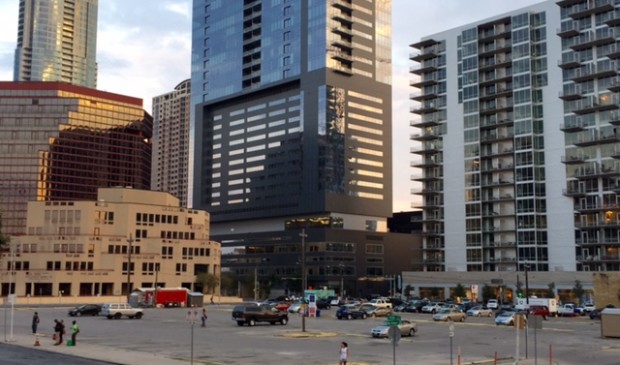Travis County approves screening process for courthouse sites
Monday, February 22, 2016 by
Caleb Pritchard Travis County planners are heading back to the laboratory to hash out the pros and cons of several select properties – including the one that voters rejected in November – that could be home to a new civil courthouse.
On Tuesday, the Travis County Commissioners Court approved the so-called site evaluation matrix that county staff, along with consulting partners at AECOM, will apply to the properties. The court voted 3-0-1 in favor of the proposal, with Commissioner Margaret Gómez abstaining and Commissioner Ron Davis off the dais.
The matrix itself is a set of multitiered criteria by which to measure any given site’s suitability to play host to courthouse.
But the team won’t run simply any given sites, at least initially. The court’s vote also lined up for the screening five county-owned locations in downtown Austin, one of which is the parking lot at 300 Guadalupe St. that was to be turned into the $287 million Civil & Family Courts Complex. Voters narrowly declined that bond proposition last year.
“That doesn’t mean there’s a commitment to build on that site. As we start over, we’re looking at all the real estate assets, particularly in downtown,” Strategic Resource Planning Manager Belinda Powell told the Austin Monitor on Thursday. She characterized the process as a thorough vetting in the name of transparency. “Ultimately, we want to be able to show to anyone who is interested when it’s all said and done how these sites stood up against each other.”
Other downtown sites include Block 126, which sits between the Heman Marion Sweatt Courthouse and the Governor’s Mansion. Severely restricted by Capitol View Corridors, Block 126 is mostly a surface parking lot on top of which sit the University Savings Building (home of the Facilities Management Department) and Constable Carlos Lopez’s Precinct 5 headquarters.
Just to the north, across West 11th Street, is Block 134. Planners will review the county-owned Granger Building and its attached parking garage, which collectively cover half of the block.
Also up for evaluation is 700 Lavaca St. – headquarters of county government – along with its colossal parking garage at 800 Lavaca St. The final site included in this round is the parking garage at San Antonio and West 10th streets, though as Powell explained to the court on Tuesday, that property is already being eyed as the future of the county’s central booking facility.
“But again, it is a site in very close proximity to where the existing court system is today,” Powell told the court. “We do think it needs to be evaluated. It has been evaluated in the past, but we do think that it is important for you to see all these things contemporaneous in time and … put through a matrix that, at the end of the day, everyone can see how the sites scored out.”
Powell told the Monitor that other county-owned properties, including Palm School, will also be evaluated in the coming weeks. The results of that process, she said, will be available to the public. Eventually, however, the team will look at private real estate, a step that will require more opacity.
County Judge Sarah Eckhardt explained: “By applying the matrix to the properties we already own, there’s no real estate buzz about it, there’s no negotiation looming over our head. We can do it very publicly. We won’t be able to do that on properties that somebody else owns.”
In all, the matrix contains around 60 different criteria organized under three separate tiers that will be used to weed out unsuitable sites. The first tier, dubbed “Fatal Flaws,” will measure each site’s market price, any regulatory overlays (such as Capitol View Corridors) and transit accessibility.
Following that, the sites must survive a gauntlet of metrics quantifying – among other things – security issues, design logistics and the financing options.
According to the timeline also approved by the court, the planning team will present its findings on the county-owned properties in early March and on any noncounty owned properties in mid-April. In mid-May, the team will unveil to the court the most viable sites capable of housing the new courthouse.
[embeddoc url=”https://www.austinmonitor.com/wp-content/uploads/2016/02/Site-Criteria-Evaluation-Matrix.pdf”]
You're a community leader
And we’re honored you look to us for serious, in-depth news. You know a strong community needs local and dedicated watchdog reporting. We’re here for you and that won’t change. Now will you take the powerful next step and support our nonprofit news organization?






